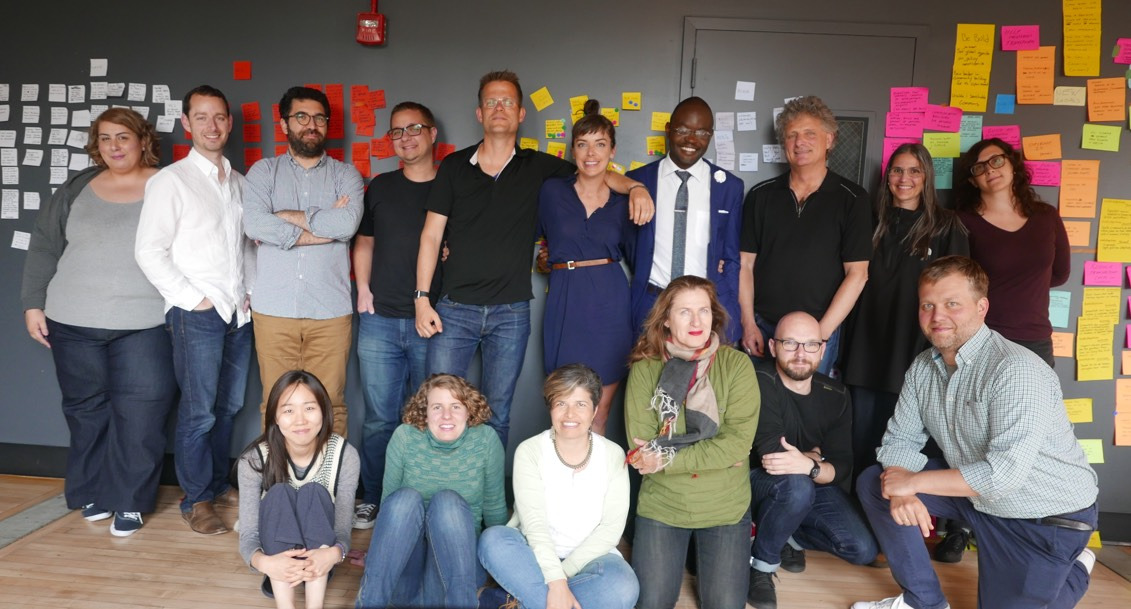
Roaming
the streets of DC,debating in breakout groups, sitting at food trucks
and over great dinners and wine we had many important conversations for
our network. What distinguishes CC network from other open movements is
our feelings of family, love and community. Even in the middle of
difficult conversations we still manage always to remember that this
love and respect for each other is what makes our network unique. As
always our time together came to an end too soon, and now we move online
and of course now expand our conversations with all of you.
Day
two had fewer post-its (protip: if you want a post-demo ask Kamil) but
more breakout groups and larger roundtable discussions. We started the
day with Reimagining CC’s Global Network. Each of us sharing visuals
depicting what the CC’s global network could be. Images ranged from Internet
Map,
Solar
system gif,
The
Shapely Supercluster,
and
Military
structures
and distributed
node structures.
Various organizational methodologies were brought to the table Chaord
model,
organizational nodes, and challenges with
distributed power networks.
“Can
we make CC exciting/creative again?”
We
broke out and discussed the purpose, goals, values and to imagine a
different world. After a morning of debates, it was clear we agree more
than not about the major goals
and purpose of CC's global network.
in our organization. Across all breakout groups ideas around Access to
knowledge, being inclusive or empowered participation and sharing and
growing the Commons.
The
framework that emerged out of the group sharing of ideas around
reimagining CC's global network.
What
do we want to achieve?
-
Imagine a different world
-
Purpose & Goals
-
Values
-
Scope of what we are working on - narrowly focused or broad
-
Initial areas of work
-
CC Strategy or something different - member defined
-
Platforms/campaigns - individual and collective
Membership
Model
-
What is the network we need?
-
What is the network we need?
-
Want low barriers to entry
-
Membership includes call to action
-
Individual members
-
Organizational members
-
Geography of membership
-
Build around goals & formation of teams
Structure/Infrastructure
-
Organize network in multiple ways - by area of interest, regionally, by
member expertise
-
Technology needed
-
Human resources needed
-
Funding needed
-
Norms and checklists - these are the ways we can work together
-
Relationship among network - interaction & communication (structure
- with a central org or not)
-
Cultural norms
-
Reward collaboration, sharing, mentoring, entrepreneurship
Both
breakout groups struggled with questions around Membership vs.
affiliate model and thinking about what how a new membership model might
look. Ideas around a lower barrier to entry, or levels of
participation, and the merits and challenges of thematic over country
teams. Wikipedia came up often as an example of low barrier to
participation and challenges and benefits of the wikimedia vs Mozilla
models. Major pain points included the chicken and egg complexity of
lack of engagement from affiliate to HQ and the tension of wanting the
affiliates to have more investment in HQ strategy and projects, and
defining active and inactive affiliates. We had a roundtable discussion
on how to engage them or allow for a change and new participants.
Once
we’ve collated and digested these busy days, we’ll come back to you
with more of our plans for communication activities and discussion for
involvement for the entire network. Some hints: think regional meetings,
surveys and interviews and project groups around copyright reform, OER
and Open Policy.
Many
thanks to Paul Stacey and Kamil Śliwowski for their tremendous work
facilitating and wrangling us and to Mari Moreshead for taking such
excellent care of us.
